Trigonometry is an important branch of mathematics that deals with the measurement of angles and sides of triangles. It is a subject that is typically introduced to students in higher grades, usually in high school. But when exactly do students start learning trigonometry?
In most school systems, trigonometry is first introduced in the 9th or 10th grade. It is often included as part of the Algebra II or Geometry curriculum. However, some students who are on an accelerated math path may start learning trigonometry as early as the 8th grade.
Trigonometry builds upon the foundation of basic geometry and algebra concepts. It involves the study of trigonometric functions such as sine, cosine, and tangent, and their relationships with angles and sides of a triangle. These functions are commonly used to solve real-world problems involving angles and distances.
In trigonometry, students learn how to calculate unknown angles or sides of a triangle using trigonometric ratios. They also learn about the unit circle, which is a powerful tool in trigonometry that helps to understand the values of trigonometric functions for any angle.
Trigonometry is not just a theoretical subject; it has practical applications in various fields such as engineering, physics, and navigation. For example, it is used in calculating distances between objects, determining the height of buildings or mountains, and analyzing waveforms in electronics.
To learn trigonometry effectively, students must have a solid understanding of basic geometry and algebra concepts. They should be comfortable working with angles, triangles, and equations. It is important for them to have a good grasp of concepts such as Pythagorean theorem, ratios, and algebraic manipulation.
Trigonometry can be a challenging subject for some students, as it introduces new concepts and requires a strong foundation in prerequisite topics. However, with proper guidance and practice, students can develop a deep understanding of trigonometry and its applications.
Trigonometry is typically taught in the 9th or 10th grade, although some students may start learning it as early as the 8th grade. It is a branch of mathematics that deals with angles and sides of triangles, using trigonometric functions such as sine, cosine, and tangent. Trigonometry has practical applications in various fields and requires a solid understanding of basic geometry and algebra concepts. With dedication and practice, students can master trigonometry and apply it to solve real-world problems.
Can 9th Graders Take Trigonometry?
It is possible for 9th graders to take trigonometry. Trigonometry is a branch of mathematics that deals with the relationships between angles and sides of triangles. It is typically taught in high school, usually as part of a more advanced math curriculum.
In some schools, trigonometry may be offered as a separate course, while in others, it may be included as a unit within a more comprehensive math course. The availability of trigonometry in 9th grade may vary depending on the school and the student’s level of math proficiency.
Taking trigonometry in 9th grade can be a great opportunity for students who have a strong foundation in algebra and geometry. Trigonometry builds upon these topics and introduces new concepts such as trigonometric functions, identities, and applications.
It is important to note that trigonometry is considered an advanced math course and may require a higher level of mathematical thinking and problem-solving skills. Students who are interested in taking trigonometry in 9th grade should consult with their school counselor or math teacher to determine if they meet the prerequisites and if it is a suitable choice for them.
Here are some key points regarding 9th graders taking trigonometry:
– Trigonometry is a branch of mathematics that deals with the relationships between angles and sides of triangles.
– It is typically taught in high school, either as a separate course or as part of a more comprehensive math curriculum.
– The availability of trigonometry in 9th grade may vary depending on the school and the student’s level of math proficiency.
– Taking trigonometry in 9th grade can be a great opportunity for students with a strong foundation in algebra and geometry.
– Trigonometry requires a higher level of mathematical thinking and problem-solving skills.
– Students interested in taking trigonometry in 9th grade should consult with their school counselor or math teacher to determine if they meet the prerequisites and if it is a suitable choice for them.

What Age Are You Supposed To Learn Trigonometry?
Trigonometry, a branch of mathematics that deals with the relationships between the angles and sides of triangles, is typically introduced in secondary school. However, the age at which students are supposed to learn trigonometry can vary depending on the educational system and curriculum of each country or school district.
In many educational systems, trigonometry is first introduced in high school, usually around the age of 14 or 15. It is often part of the curriculum for students studying advanced mathematics or preparing for college-level math courses. At this stage, students are expected to have a solid foundation in basic arithmetic, algebra, and geometry.
However, it is worth noting that some schools or educational programs may choose to introduce trigonometry concepts earlier, such as in sixth-grade honors classes. In these cases, students may learn basic trigonometric concepts, such as understanding the relationships between angles and sides in right triangles, and how to use trigonometric functions like sine, cosine, and tangent.
Introducing elementary trigonometry at a younger age can provide students with a head start in developing their mathematical skills and understanding of geometric concepts. It can also help lay the groundwork for more advanced mathematical topics that students may encounter later in their education.
To summarize, trigonometry is typically introduced in high school, around the age of 14 or 15. However, some schools or programs may introduce basic trigonometric concepts at an earlier age, such as in sixth-grade honors classes. The specific age at which students learn trigonometry can vary depending on the educational system and curriculum.
Does Grade 11 Have Trigonometry?
Grade 11 does cover the topic of trigonometry. Trigonometry is a fundamental branch of mathematics that focuses on the relationship between the angles and sides of a triangle. In Grade 11, students typically study trigonometry as part of their high school mathematics curriculum.
Here are some key points about trigonometry in Grade 11:
1. Introduction to Trigonometry: In Grade 11, students are introduced to the basic concepts and principles of trigonometry. They learn about the trigonometric functions such as sine, cosine, and tangent, and how these functions relate to the angles and sides of a right triangle.
2. Right Triangle Trigonometry: Students learn how to use trigonometric ratios to solve problems involving right triangles. They learn how to find the lengths of sides and measures of angles in a right triangle using trigonometric functions.
3. Trigonometric Identities: Grade 11 students also study trigonometric identities, which are equations involving trigonometric functions that hold true for all values of the variables. They learn how to manipulate and simplify trigonometric expressions using these identities.
4. Applications of Trigonometry: Trigonometry is not just a theoretical concept; it has numerous practical applications. In Grade 11, students explore real-world applications of trigonometry, such as solving problems involving heights and distances, angles of elevation and depression, and navigation problems.
5. Trigonometric Equations: Students also learn how to solve trigonometric equations in Grade 11. They learn different methods and techniques to solve equations involving trigonometric functions and find the values of variables.
It is important to note that the depth and complexity of trigonometry covered in Grade 11 may vary depending on the specific curriculum or educational system. However, in general, trigonometry is a significant topic that students encounter during their Grade 11 mathematics studies.
What Math Do 11th Graders Take?
In the 11th grade, students typically take advanced math courses that build upon the foundational knowledge gained in previous years. The specific math courses offered may vary depending on the school or district. However, the most common math course taken by 11th graders is Algebra II. This course delves deeper into algebraic concepts, including functions, equations, and graphing. It also introduces more advanced topics such as logarithms, exponential functions, and conic sections.
In addition to Algebra II, some 11th graders may have the option to take other advanced math courses such as Pre-Calculus or Trigonometry. Pre-Calculus covers a wide range of topics including trigonometry, functions, matrices, and complex numbers. Trigonometry focuses primarily on angles, triangles, and trigonometric functions.
It is important to note that the availability of these advanced math courses may depend on the student’s academic performance, school policies, and individual course offerings. Some students may also have the opportunity to take Advanced Placement (AP) math courses such as AP Calculus AB or BC, which are college-level courses that can earn them college credit if they pass the corresponding AP exam.
The math courses typically taken by 11th graders include Algebra II, Pre-Calculus, Trigonometry, and potentially AP Calculus AB or BC. However, it is important to consult with the specific school or district to determine the exact math courses available at the 11th grade level.

Conclusion
Trigonometry is a fascinating branch of mathematics that deals with the measurement of angles and sides of triangles. It is a fundamental tool for understanding and solving various real-world problems, especially those related to geometry, physics, and engineering.
Through the study of Trigonometry, students develop a deep understanding of the relationships between angles and sides in right triangles, as well as the properties of trigonometric functions such as sine, cosine, and tangent. These functions not only help in solving triangle-related problems but also have applications in fields such as navigation, astronomy, and computer graphics.
Trigonometry provides students with valuable problem-solving skills and analytical thinking abilities. By applying trigonometric concepts, students can determine unknown angles or sides of triangles, calculate distances and heights, analyze periodic phenomena, and even model real-life situations.
Furthermore, Trigonometry serves as a stepping stone for higher-level mathematics, such as Calculus and advanced engineering courses. It provides students with a solid foundation in mathematical reasoning and helps them develop critical thinking skills that are essential for success in various academic and professional fields.
Trigonometry is a crucial subject that not only has practical applications but also enhances students’ mathematical knowledge and problem-solving abilities. It is a subject that encourages logical thinking, fosters creativity, and equips students with the skills necessary to tackle complex problems in various disciplines. Therefore, a strong understanding of Trigonometry is highly beneficial for students pursuing careers in STEM fields or any area that requires a solid mathematical background.
